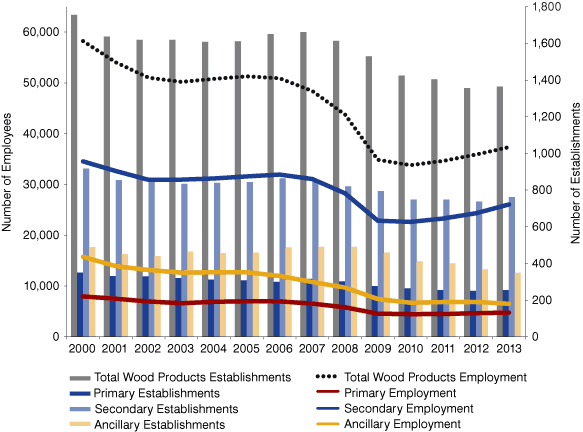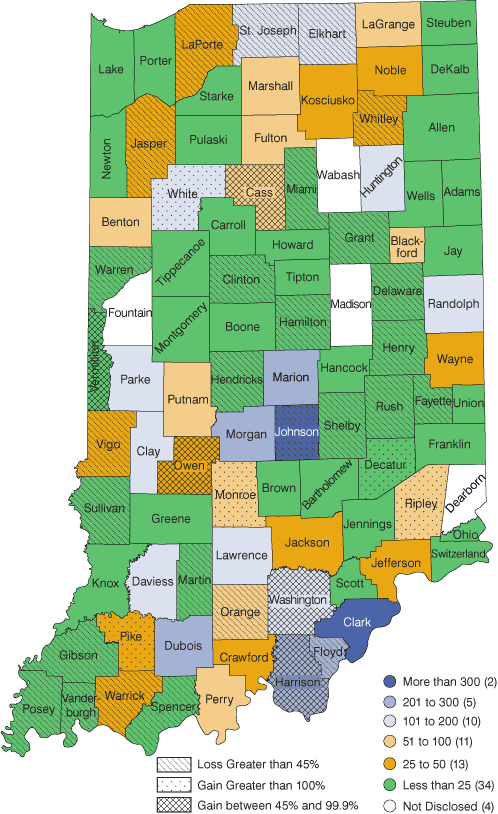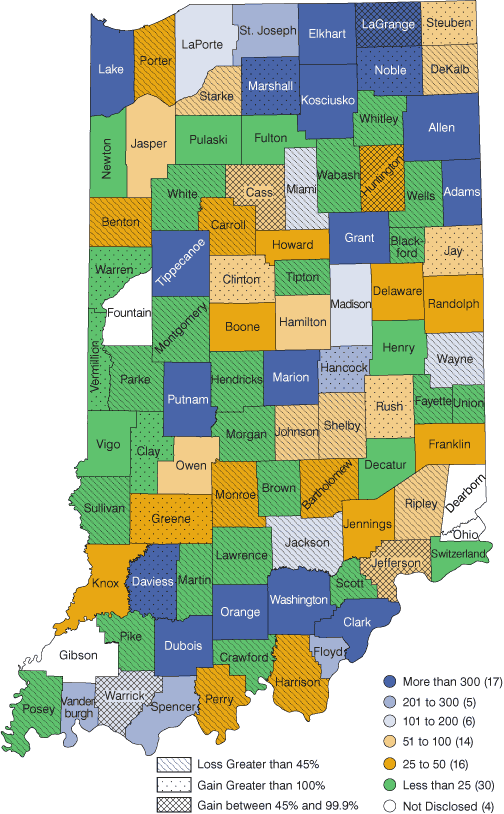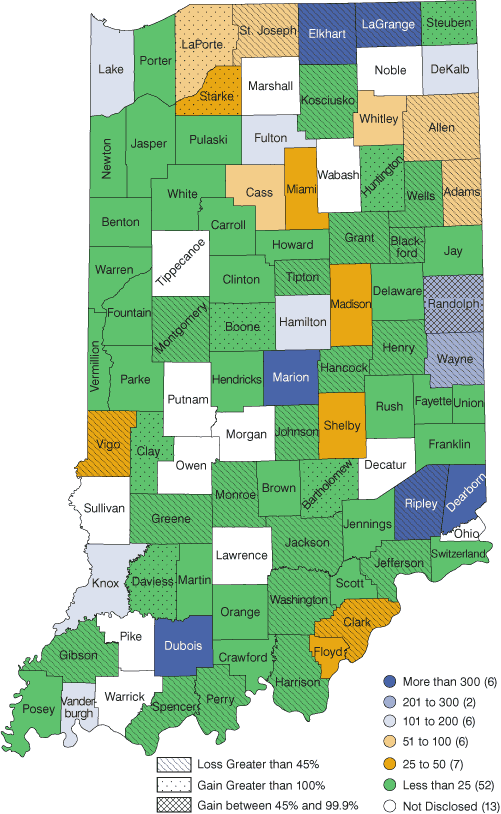The Great Recession's Influence on Indiana's Wood Products Industry
As a state, we often take for granted the abundance, quality and value of the forestland that comprises approximately 20 percent of Indiana’s land area. Within the wood products industry, the state is known for its hardwoods, especially oak and hickory. Similar to other industries, forestry was heavily impacted by the recession. This article will explore Indiana’s wood products industry and articulate the economic trends before and after the Great Recession.
The Forestry Industry
Indiana will likely never return to the time where forestland covered 85 percent of the state (in 1800), due to the need for clearing for agriculture, community development and infrastructure. Interestingly, however, the current forestlands have stayed relatively the same since 1860.
The forestry industry entails more than the logging of trees; rather, it is routinely classified into three sectors—primary, secondary and ancillary.
The primary wood products sector includes firms that harvest, transport and perform the initial processing of logs. By adding additional value to wood, the secondary wood products sector includes businesses that dry, plane, cut and assemble wood products into parts or finished products. The final ancillary sector is comprised of firms that are related to the industry, but are not directly a part of either primary or secondary wood product sectors.
Table 1 shows the breakdown of each sector based on the North American Industry Classification System (NAICS) and the corresponding 2013 data on establishments, employment and average wage from the Quarterly Census of Employment and Wages (QCEW) produced by the U.S. Bureau of Labor Statistics.
Table 1: Wood Products Industry by Sector, 2013
| Sector | NAICS | Industry |
|---|---|---|
| Primary 4,767 Employees 254 Establishments $34,993 Average Wage |
113110 | Timber Tract Operations |
| 113210 | Forest Nurseries and Gathering of Forest Products | |
| 113310 | Logging | |
| 321912 | Cut Stock, Resawing, Lumber and Planing | |
| 321113 | Sawmills | |
| 321114 | Wood Preservation | |
| 321211 | Hardwood Veneer and Plywood Manufacturing | |
| 321212 | Softwood Veneer and Plywood Manufacturing | |
| 321213 | Engineered Wood Member (except Truss) Manufacturing | |
| 321214 | Truss Manufacturing | |
| 321219 | Reconstituted Wood Product Manufacturing | |
| Secondary 26,070 Employees 762 Establishments $36,367 Average Wage |
321911 | Wood Window and Door Manufacturing |
| 321918 | Other Millwork (including Flooring) | |
| 321920 | Wood Container and Pallet Manufacturing | |
| 337110 | Wood Kitchen Cabinet and Countertop Manufacturing | |
| 337121 | Upholstered Household Furniture Manufacturing | |
| 337122 | Non-upholstered Wood Household Furniture Manufacturing | |
| 337127 | Institutional Furniture Manufacturing | |
| 337129 | Wood Television, Radio and Sewing Machine Cabinet Manufacturing | |
| 337211 | Wood Office Furniture Manufacturing | |
| 337212 | Custom Architectural Woodwork and Millwork Manufacturing | |
| 337215 | Showcase, Partition, Shelving and Locker Manufacturing | |
| 337920 | Blind and Shade Manufacturing | |
| 321999 | All Other Miscellaneous Wood Product Manufacturing | |
| Ancillary 6,505 Employees 349 Establishments $47,368 Average Wage |
115310 | Support Activities for Forestry |
| 321991 | Manufactured Home (Mobile Home) Manufacturing | |
| 321992 | Prefabricated Wood Building Manufacturing | |
| 339995 | Burial Casket Manufacturing | |
| 423210 | Furniture Merchant Wholesalers | |
| 423310 | Lumber, Plywood, Millwork and Wood Panel Merchant Wholesalers |
Source: Purdue Extension, using definitions from the Louisiana Forest Products Development Center and U.S. Bureau of Labor Statistics Quarterly Census of Employment and Wages data
Trends
The wood products industry tends to follow the economic cycles, thus it’s of interest to see if that trend held true since 2000 (2013 is the most recent data year available). During this time, the state experienced an economic boom, two downturns and has since had lethargic, yet steady, growth. Figure 1 shows the general trend of the employment and establishments over time for Indiana in both aggregate and by wood products sector.
Figure 1: Indiana Wood Products Industry Employment and Establishment Trends

Source: Purdue Extension, using U.S. Bureau of Labor Statistics Quarterly Census of Employment and Wages data
The Great Recession began in December 2007 and ended in June 2009, thus analysis was done looking at several points in time for Indiana: 2000-2013, 2003-2006 (prior to recession), 2007-2009 (during the recession) and 2010-2013 (post-recession).
Impact of Recession on Counties
The employment trends of the wood products industry varies considerably among counties. As of 2013, the top three counties that employ wood products industry workers were Dubois, Elkhart and Marion counties. These top three counties have not changed over the past 13 years. Table 2 shows the counties with the most substantial employment change in percentage terms since 2000. Hancock County led the way with a 381 percent change in employment since 2000, largely due to expansions within the secondary wood products sector. Wabash County had one of the largest losses in employment, due to drawdowns in both primary and secondary wood products establishments.
Table 2: Top Employment Changes in the Wood Products Industry
| County | Job Growth since 2000 | Change | County | Job Decline since 2000 | Change |
|---|---|---|---|---|---|
| Hancock | 179 | 380.9% | Wabash | -112 | -95.7% |
| Boone | 44 | 366.7% | Carroll | -460 | -94.5% |
| Noble | 252 | 237.7% | Scott | -69 | -83.1% |
| Steuben | 37 | 132.1% | Henry | -83 | -78.3% |
| Grant | 531 | 107.9% | Bartholomew | -166 | -74.1% |
| Daviess | 280 | 99.6% | Jackson | -439 | -73.5% |
| Decatur | 15 | 93.8% | Shelby | -324 | -70.4% |
| Jay | 46 | 86.8% | Harrison | -621 | -69.5% |
| Huntington | 77 | 70.0% | Johnson | -889 | -65.8% |
| Marshall | 194 | 39.8% | Sullivan | -80 | -65.6% |
Source: Purdue Extension, using U.S. Bureau of Labor Statistics Quarterly Census of Employment and Wages data
Primary Wood Products Sector
The primary wood products sector consists of firms that harvest, transport and conduct the initial processing of logs. In 2013, Indiana had 254 of these firms with 4,767 employees, earning an average annual wage of $34,993. These jobs are present throughout the state: the top three employing counties being Johnson, Clark and Dubois counties (see Figure 2). Over the last 13 years, only two industries within this sector saw employment growth—softwood veneer and plywood manufacturing and engineered wood member (except truss) manufacturing, gaining a total of 255 jobs. These same two industries also had the largest employment growth since the recession, for a total of 425 jobs.
Figure 2 : Primary Wood Products Employment by County, 2000 to 2013

Source: Purdue Extension, using U.S. Bureau of Labor Statistics Quarterly Census of Employment and Wages data
Statewide, the primary sector had a 40.1 percent loss in employment and a 27.4 percent decline in establishments. Since the end of the recession, Vigo County has seen the most expansion (1,467 percent) followed by Warrick county (255 percent) and White county (146 percent). However, Vigo and Warrick counties have lost a total of 173 jobs in the past decade—thus it appears they are rebounding. On the other end of the spectrum, several counties are still shedding jobs, such as Hamilton County (80 percent), Sullivan County (59 percent) and Floyd County (31 percent). All three of these counties have been on the downward trend since 2003.
Secondary Wood Products Sector
Businesses in the secondary wood products sector further add value to wood by drying, planing, cutting and assembling wood products into parts or finished products. In 2013, Indiana had 762 of these businesses, employing 26,070 workers at an average wage of $36,367. Dubois County remains the hub of secondary wood production in Indiana with over 6,452 employees followed by Elkhart County (4,902 employees). All other counties have significantly fewer employees than these two counties (see Figure 3).
Figure 3 : Secondary Wood Products Employment by County, 2000 to 2013

Source: Purdue Extension, using U.S. Bureau of Labor Statistics Quarterly Census of Employment and Wages data
This sector had the largest quantity of employment loss statewide during the recession years (8,228 employees), yet has also had the strongest rebound since 2010 (3,435 employees). Forty percent of this rebound came from the wood kitchen cabinet and countertop manufacturing industry. Counties with the strongest percent gains in employment since the end of the recession had relatively small initial employment numbers (fewer than 25 employees). Jay, Grant, Kosciusko and Putnam counties were exceptions, which collectively have seen a growth of 982 employees since 2010. Counties who used to have a workforce greater than 200 in secondary wood products, yet have experienced a continuous decline in employment in the last decade include Wayne, Harrison, Carroll, Shelby and Miami counties. In total, these counties have lost 1,713 employees since 2003 with 367 employees lost after the recession.
Ancillary Wood Products Sector
The ancillary sector includes firms related to the forestry industry but that are not directly a part of the primary or secondary wood product sectors. As of 2013, Indiana had 349 firms employing 6,505 workers at an average wage of $47,368 in the ancillary sector. Elkhart remains the county with the largest pool of ancillary wood products industry workers (1,880), due to the presence of manufactured home manufacturing firms (see Figure 4). The next largest employing county was Marion County (700 employees), likely due to the large number of wood products’ wholesalers. Ripley County, the home of burial casket manufacturing firms, ranked third with 440 workers in 2013.
Figure 4 : Ancillary Wood Products Employment by County, 2003-2013

Source: Purdue Extension, using U.S. Bureau of Labor Statistics Quarterly Census of Employment and Wages data
Of the top 10 employing counties in 2013, 90 percent lost workers in the past decade—culminating to a total of 4,815 jobs. Since the end of the recession, only 17 counties have seen employment growth in this sector, with LaGrange County leading the pack with 167 new jobs (78 percent growth). Statewide, manufactured home and prefabricated wood building manufacturing sectors have had the most severe employment loss (-76.5 percent and -78.5 percent, respectively) since 2000. It is still speculated that this sector may be increasing the use of automated production, thus eliminating positions formerly held by individuals. The aforementioned industries may have experienced the automation the most, thus explaining the dramatic drop in employment since 2000. All other industries within the ancillary sector have also experienced a decline in employment, but none as severe as the manufactured home and prefabricated wood building manufacturing industries.
Exports of Indiana Wood Products
In 2014, Indiana exported $194.5 million of goods to other countries, down from the peak experienced in 2007 ($232.4 million), yet a 23 percent increase from 2004’s export value.1 Of all the agricultural exports leaving the state, 11.3 percent are wood products. In 2004 (earliest time provided), wood products comprised 32.1 percent; however, total agricultural exports have more than tripled in the past decade.
Nationally, Indiana ranked 17th among states for wood product exports in 2014. Among hardwood-producing states east of the Mississippi River, Indiana ranked 10th.2 The top three exported items in both 2004 and 2014 were sawn sheet wood, oak lumber and non-coniferous lumber (primary sector)—comprising 51 percent of all exports.
In 2014, the top five export destinations for Indiana’s wood products were Canada, China, Japan, Mexico and Germany; capturing 71.9 percent of all exports. Mexico’s demand for Indiana’s wood products accelerated in 2005, placing it in the top 10 destinations. The remaining top four destinations have historically been strong markets for Indiana. The top imported wood product by the leading destinations were as follows:
- Canada and Germany: Sawn sheet wood
- Japan: Oak and non-coniferous lumber
- China: Ash lumber as well as non-coniferous and oak logs
- Mexico: Non-coniferous lumber
Conclusions
Indiana’s forests produce high quality wood that is converted into many different uses. Indiana is fortunate to have a productive and high quality stand of forestland, yet the industry is vulnerable to economic cycles. Eleven percent of all exported agricultural products are wood products, but that has not kept the pace with other agriculture exports. Opportunities abound to further enhance the value of Indiana wood products to the economy through its export channels. Doing so would likely help diversify existing markets and mitigate the effects from national economic cycles.
Notes
- The 2010 article on wood products manufacturing (www.incontext.indiana.edu/2010/sept-oct/article5.asp) used WISERTrade as its data source, whereas the Global Agricultural Trade Service was used for this article—hence the differences in numbers.
- Included states are Pennsylvania, Tennessee, Virginia, West Virginia, Kentucky, Wisconsin, New York, Ohio, Georgia, Indiana, Alabama, Maryland and Vermont.
